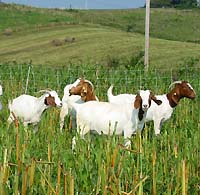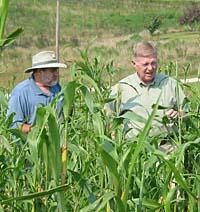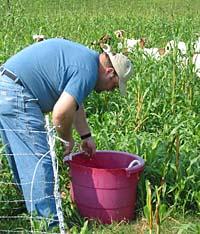Goats Provide Opportunity on Southern KY Farm
Goats Provide Opportunity on Southern KY Farm


Terry Hutchens (left) and Keenan Turner (right) discuss grazing patterns of goats.
Once upon a hillside in the small community of Naomi, tobacco dominated the usual summer scene. Now neighbors stop and stare at more than 100 goats grazing Sorghum-Sudan on the same hillside.
Tim Burton is just one of many farmers trying to find another enterprise to replace at least a portion of the income he used to bring in by growing tobacco. For him, it’s been pure success thus far.
“We know there’s not any one enterprise that is going to take the place of tobacco,” said Keenan Turner, Extension agent for agriculture and natural resources in Pulaski County. “I do think the goat enterprise will help us to replace some of that income.”
Turner estimates that close to $100,000 of lost tobacco income has been made up in Pulaski County by producers choosing to add goats to their enterprises.
Burton and Turner are working together with Terry Hutchens, Extension associate for goat production with the University of Kentucky Cooperative Extension Service, to find ways to make goat enterprises more cost efficient and profitable for producers. Burton raises more than 100 goats, mostly for breeding stock.
“We’ve been into goats for about six years,” Burton said. “We did tobacco until about two years ago and we just weren’t making any money on it. But we’re doing well with goats. Working with Extension helps with the feed bills, worming bills and we aren’t feeding any supplements, which also saves money.”
Hutchens said the goal of the project with Burton is to find an economical way to feed female goats through the summer and to reduce common parasite infections goats easily obtain by grazing perennial pastures such as fescue and clover.
“Sorghum-Sudan is a summer annual with fast regrowth potential and it also produces a lot of dry matter, or feed, for goats,” he said. “This means we can graze a large number of goats in a small area.”
The research is comparing a group of 16 goats continuously grazing the same area to a group of 16 goats that are being moved from paddock to paddock once the top growth of the crop is eaten.

Tim Burton finishes moving goats to a fresh paddock of Sorghum Sudan.
Hutchens said last year, the first year of the project, there was a significant difference between the two groups.
“By the end of the season, there was no forage left on the continuously-grazed pasture,” he said. “But on the rotationally-grazed areas there was as much as 4,000 pounds of dry matter per acre after three weeks of rest.”
They also saw fewer problems with parasites. Parasites have to stay out of the sun and in a film of water, so they usually live from ground level to about 3 to 5 inches up the plant stem. Since goats naturally prefer to feed from the top of a plant down, it only stands to reason that moving them off a paddock once the top is grazed will keep them from the parasite-laden bottom of the plant.
“Permanent pastures promote parasite growth, so it’s important to move goats off of these for a little while,” Hutchens said. “The parasite cycle has to be broken.”
Goat production is much less labor intense than tobacco, Turner said. The most important thing is fencing.
“You’ve got to have a good exterior fence,” he said. “That way if the goats get out, at least they are still on your property. Interior fencing is important too in rotational grazing. It’s easy to move them; they’ll follow a bucket. It really is a low labor enterprise in comparison.”
Burton’s mother Wilma Burton is glad for the easier enterprise. She had a heart attack a few years back and just hasn’t been able to keep up with labor-intensive enterprises like cattle and tobacco. Since Tim works a fulltime job in town, Wilma is the one who is always home at the farm.
“I can handle the goats better than cattle or tobacco,” she said. “I really enjoy working with them. You have to be careful though, it’s easy to get attached to the young ones.”
Tim Burton is the president of the growing Pulaski County Goat Association. He said they have about 38 members. Currently they are working to get a 4-H goat show going in the county. Turner and Burton emphasized that getting youth involved in the goat enterprise would be valuable for the adults and the kids.
“My 8-year-old son shows goats,” Burton said. “He’s learned a lot about taking care of animals through that. He’s learned a lot about responsibility.”
The research project is funded by a grant from the Sustainable Agriculture Research Education program. SARE provides grants and information to improve the profitability, stewardship and quality of life.
